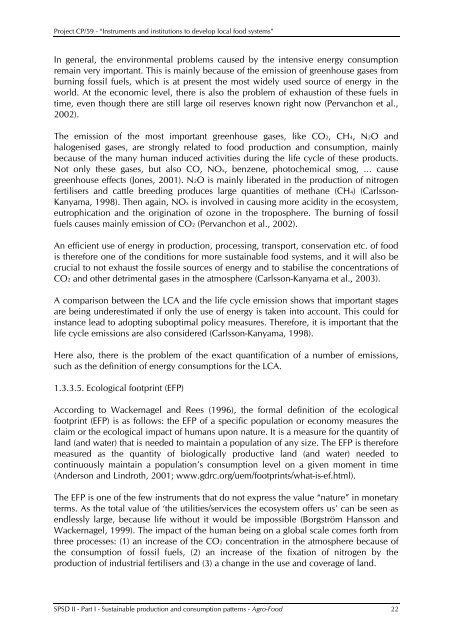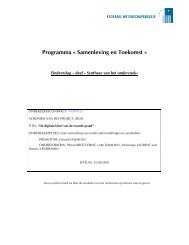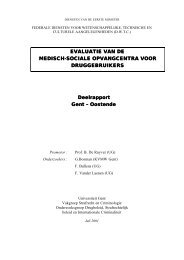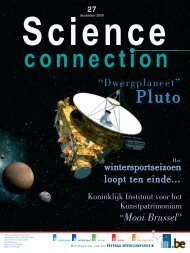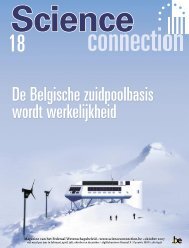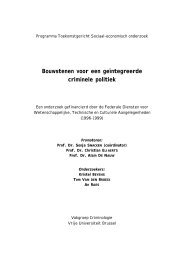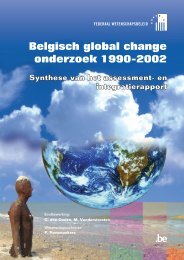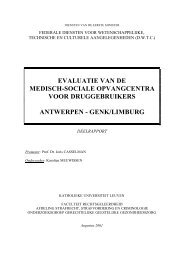chapter 3 inventory of local food systems
chapter 3 inventory of local food systems
chapter 3 inventory of local food systems
You also want an ePaper? Increase the reach of your titles
YUMPU automatically turns print PDFs into web optimized ePapers that Google loves.
Project CP/59 - “Instruments and institutions to develop <strong>local</strong> <strong>food</strong> <strong>systems</strong>”<br />
In general, the environmental problems caused by the intensive energy consumption<br />
remain very important. This is mainly because <strong>of</strong> the emission <strong>of</strong> greenhouse gases from<br />
burning fossil fuels, which is at present the most widely used source <strong>of</strong> energy in the<br />
world. At the economic level, there is also the problem <strong>of</strong> exhaustion <strong>of</strong> these fuels in<br />
time, even though there are still large oil reserves known right now (Pervanchon et al.,<br />
2002).<br />
The emission <strong>of</strong> the most important greenhouse gases, like CO2, CH4, N2O and<br />
halogenised gases, are strongly related to <strong>food</strong> production and consumption, mainly<br />
because <strong>of</strong> the many human induced activities during the life cycle <strong>of</strong> these products.<br />
Not only these gases, but also CO, NOx, benzene, photochemical smog, … cause<br />
greenhouse effects (Jones, 2001). N2O is mainly liberated in the production <strong>of</strong> nitrogen<br />
fertilisers and cattle breeding produces large quantities <strong>of</strong> methane (CH4) (Carlsson-<br />
Kanyama, 1998). Then again, NOx is involved in causing more acidity in the ecosystem,<br />
eutrophication and the origination <strong>of</strong> ozone in the troposphere. The burning <strong>of</strong> fossil<br />
fuels causes mainly emission <strong>of</strong> CO2 (Pervanchon et al., 2002).<br />
An efficient use <strong>of</strong> energy in production, processing, transport, conservation etc. <strong>of</strong> <strong>food</strong><br />
is therefore one <strong>of</strong> the conditions for more sustainable <strong>food</strong> <strong>systems</strong>, and it will also be<br />
crucial to not exhaust the fossile sources <strong>of</strong> energy and to stabilise the concentrations <strong>of</strong><br />
CO2 and other detrimental gases in the atmosphere (Carlsson-Kanyama et al., 2003).<br />
A comparison between the LCA and the life cycle emission shows that important stages<br />
are being underestimated if only the use <strong>of</strong> energy is taken into account. This could for<br />
instance lead to adopting suboptimal policy measures. Therefore, it is important that the<br />
life cycle emissions are also considered (Carlsson-Kanyama, 1998).<br />
Here also, there is the problem <strong>of</strong> the exact quantification <strong>of</strong> a number <strong>of</strong> emissions,<br />
such as the definition <strong>of</strong> energy consumptions for the LCA.<br />
1.3.3.5. Ecological footprint (EFP)<br />
According to Wackernagel and Rees (1996), the formal definition <strong>of</strong> the ecological<br />
footprint (EFP) is as follows: the EFP <strong>of</strong> a specific population or economy measures the<br />
claim or the ecological impact <strong>of</strong> humans upon nature. It is a measure for the quantity <strong>of</strong><br />
land (and water) that is needed to maintain a population <strong>of</strong> any size. The EFP is therefore<br />
measured as the quantity <strong>of</strong> biologically productive land (and water) needed to<br />
continuously maintain a population’s consumption level on a given moment in time<br />
(Anderson and Lindroth, 2001; www.gdrc.org/uem/footprints/what-is-ef.html).<br />
The EFP is one <strong>of</strong> the few instruments that do not express the value “nature” in monetary<br />
terms. As the total value <strong>of</strong> ‘the utilities/services the ecosystem <strong>of</strong>fers us’ can be seen as<br />
endlessly large, because life without it would be impossible (Borgström Hansson and<br />
Wackernagel, 1999). The impact <strong>of</strong> the human being on a global scale comes forth from<br />
three processes: (1) an increase <strong>of</strong> the CO2 concentration in the atmosphere because <strong>of</strong><br />
the consumption <strong>of</strong> fossil fuels, (2) an increase <strong>of</strong> the fixation <strong>of</strong> nitrogen by the<br />
production <strong>of</strong> industrial fertilisers and (3) a change in the use and coverage <strong>of</strong> land.<br />
SPSD II - Part I - Sustainable production and consumption patterns - Agro-Food 22


